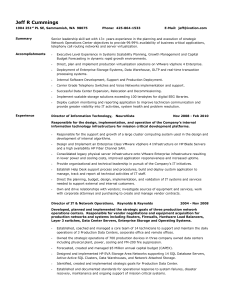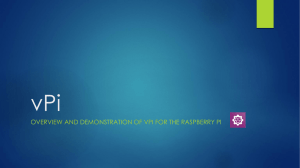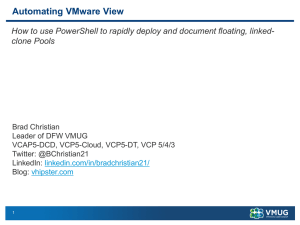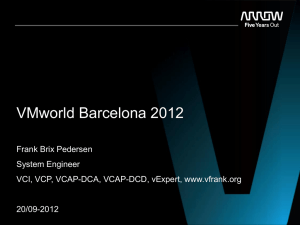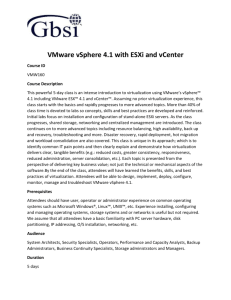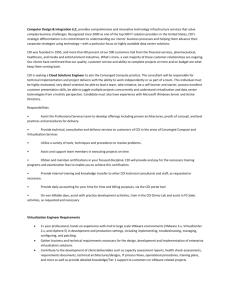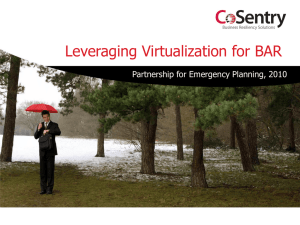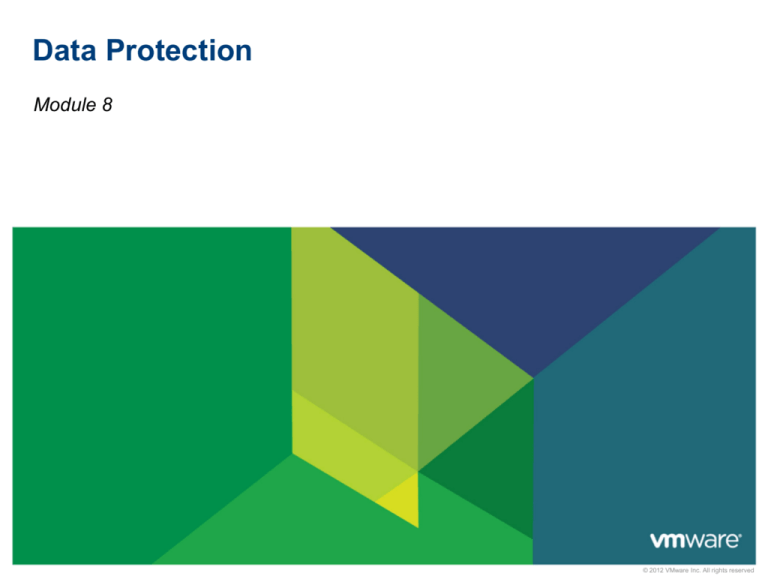
Data Protection
Module 8
© 2012 VMware Inc. All rights reserved
You Are Here
Course Introduction
Data Protection
Introduction to Virtualization
Access and Authentication Control
Creating Virtual Machines
Resource Management and Monitoring
VMware vCenter Server
High Availability and Fault Tolerance
Configuring and Managing Virtual Networks
Host Scalability
Configuring and Managing vSphere Storage
Patch Management
Virtual Machine Management
Installing VMware vSphere Components
VMware vSphere: Install, Configure, Manage – Revision A
8-2
© 2012 VMware Inc. All rights reserved
Importance
Over time, your VMware vSphere® environment might undergo
changes to its hardware or software configuration. In addition,
application data goes through constant change.
From a manageability perspective, making regular backups of your
vSphere environment is important.
Backing up virtual machines requires strategies that leverage
virtualization architecture to perform highly efficient backups.
VMware vSphere: Install, Configure, Manage – Revision A
8-3
© 2012 VMware Inc. All rights reserved
Learner Objectives
After this module, you should be able to do the following:
Describe the problems when using traditional backup in virtual
infrastructure.
Describe solutions for backing up and restoring virtual machines that
use virtual infrastructure.
Discuss technologies that make virtual machine backup and restore
operations faster and easier.
Describe how to back up and restore a virtual machine.
Describe how to back up and restore VMware® vCenter Server™.
Discuss a strategy for backing up and restoring a VMware vSphere®
ESXi™ host’s configuration data.
VMware vSphere: Install, Configure, Manage – Revision A
8-4
© 2012 VMware Inc. All rights reserved
Traditional Backup Method
physical server
physical server
backup agent
backup server
(uses nearly 100 percent of
server resources during backup)
operating system
operating system
x86 architecture
x86 architecture
network
connection
backup to tape or disk
VMware vSphere: Install, Configure, Manage – Revision A
data to back up
8-5
© 2012 VMware Inc. All rights reserved
Backup Challenges in Virtualized Environments
traditional backup method
backup
server
VMware vSphere
Excessive physical resource use generated by each virtual machine.
Backup agents installed in virtual machines monopolize host CPU
resources during backups, which results in less CPU resource for
other virtual machines running on that ESXi host.
I/O resources like network and storage are also saturated with read
and write operations during backup.
VMware vSphere: Install, Configure, Manage – Revision A
8-6
© 2012 VMware Inc. All rights reserved
Virtual Architecture Advantages
No backup agent installation is required.
Use of virtual machine snapshot functions is enabled.
Backup processing is offloaded from ESXi hosts to a backup server.
Virtual machines see the same virtual hardware.
Virtual disks can be thin-provisioned.
Faster backup and recovery times are enabled through the use of
changed block tracking and data deduplication.
A single backup image can be created.
Both image-level and file-level restoration can be performed.
VMware vSphere: Install, Configure, Manage – Revision A
8-7
© 2012 VMware Inc. All rights reserved
vSphere Storage APIs – Data Protection
VMware vSphere® Storage APIs − Data Protection (VADP):
Enables backup and recovery of entire virtual machine images across
SAN storage or local area networks
Is an API that is directly integrated with backup tools from third-party
vendors
Enables you to remove load from the host and consolidate backup load
onto a central backup server
Protects virtual machines that use any type of storage supported by
ESXi (Fibre Channel, iSCSI, NAS, or local storage)
VMware vSphere: Install, Configure, Manage – Revision A
8-8
© 2012 VMware Inc. All rights reserved
Offloaded Backup Processing
backup
server
VMware vSphere
mount virtual
disks to backup
server
tape
disk
Configure the storage environment so that the backup server can access
the storage volumes that are managed by the ESXi hosts.
Backup processing is offloaded from the ESXi host to the backup server,
which prevents local ESXi resources from becoming overloaded.
VMware vSphere: Install, Configure, Manage – Revision A
8-9
© 2012 VMware Inc. All rights reserved
Changed Block Tracking
virtual machine H/W version 9
ctkEnabled=true
scsi0:0.ctkEnabled=true
scsi1:0.ctkEnabled=true
virtual machine H/W
version 7
ctkEnabled=true
scsi0:0.ctkEnabled=true
-ctk.vmdk
-ctk.vmdk
-ctk.vmdk
Copy only file blocks that have changed since the last backup.
Changed block tracking enables faster incremental backups and
near-continuous data protection.
VMware vSphere: Install, Configure, Manage – Revision A
8-10
© 2012 VMware Inc. All rights reserved
Data Deduplication
storage array
backup 1
backup 2
backup 3
unique file blocks
Data deduplication has the following characteristics:
Does not store twice those blocks with the same information as a
previous backup
Reduces 12 file blocks to 4 unique file blocks
Saves storage capacity
Provides faster backup performance
VMware vSphere: Install, Configure, Manage – Revision A
8-11
© 2012 VMware Inc. All rights reserved
VMware vSphere Data Protection
Easy, disk-based backup and recovery solution for virtual machines:
Pre-configured virtual machine appliance
Agent-less, web-based backup and recovery management
Patented de-duplication technology
Entire virtual machine and file-level restores
Included with all versions of VMware vSphere (except Essentials)
VMware vSphere: Install, Configure, Manage – Revision A
8-12
© 2012 VMware Inc. All rights reserved
vSphere Data Protection Details
Scalability (maximums):
100 virtual machines per VDP appliance
10 appliances per vCenter Server
2 TB of deduplicated storage
•
Appliances deployed with .5 TB, 1 TB, or 2 TB
Efficient backup mechanism:
vSphere API for Data Protection (VADP)
Changed Block Tracking (CBT)
Variable-length segment size
Deduplication across all virtual machines performed in VDP appliance
SCSI hot add, which avoids copying entire .vmdk across network
VMware vSphere: Install, Configure, Manage – Revision A
8-13
© 2012 VMware Inc. All rights reserved
vSphere Data Protection Key Components
vSphere
Virtual Machine Appliance:
Linux virtual machine .ova
package
Easy, fast deployment
vSphere
vSphere Infrastructure:
Changed Block Tracking
VSS in VMware Tools
Appliance Storage Sizes:
.5 TB
1 TB
2TB
vCenter Server
VMware vSphere®
Web Client
VMware vSphere: Install, Configure, Manage – Revision A
vCenter Integration:
Manage through Web
client
8-14
© 2012 VMware Inc. All rights reserved
VDP Architecture
vCenter
Server
vSphere Data
Protection
VDP Appliance
4 vCPUs, 4 GB RAM
850GB, 1.6 TB or 3.1 TB
SLES 11 64-bit
vCenter Server 5.1
vSphere
vSphere 4.0 or higher
vSphere Web
Client
Deduplication Store
(.vmdk files)
VMware vSphere: Install, Configure, Manage – Revision A
8-15
© 2012 VMware Inc. All rights reserved
VDP Deployment and Configuration
After installation, VDP-configure is in “maintenance mode”:
Status - Services and logs
Configuration - Network, vCenter, and system settings
Rollback - Roll back repository of backups (more on this later)
Upgrade - Upgrade VDP appliance
VMware vSphere: Install, Configure, Manage – Revision A
8-16
© 2012 VMware Inc. All rights reserved
Virtual Machine Backup
Select objects containers (data
center, folder, clusters,
and so on) and
individual virtual
machines
VMware vSphere: Install, Configure, Manage – Revision A
8-17
© 2012 VMware Inc. All rights reserved
Restoring a Virtual Machine
VMware vSphere: Install, Configure, Manage – Revision A
8-18
© 2012 VMware Inc. All rights reserved
File Level Restore (FLR)
Restore individual files from backup:
VMware vSphere® Data Protection™ Restore Client:
•
http://<VDP ip address>:8580/flr
VMware® Tools™ must be installed.
Windows NTFS and Linux LVM, Ext 2, Ext 3 are supported (basic
disks).
View all restore points
or filter by date
VMware vSphere: Install, Configure, Manage – Revision A
8-19
© 2012 VMware Inc. All rights reserved
VDP Reporting - User Interface
VDP appliance
capacity
Success and failures
at a glance
List of virtual
machines, Backup
Jobs, and so on, with
the ability to filter
Details for object
VMware vSphere: Install, Configure, Manage – Revision A
8-20
© 2012 VMware Inc. All rights reserved
Backing Up vCenter Server
Choose a complementary backup solution that matches your vCenter
Server deployment.
Perform a full backup of your vCenter Server system.
Before starting backups, stop these services:
VMware vCenter Server
VMware VCMSDS (the Active Directory Application Mode database)
Database service (SQL, Oracle, DB2)
Back up the vCenter Server database, using recommended practices
provided by the database vendor.
Back up the SSL certificates.
Back up the vpxd.cfg file.
VMware vSphere: Install, Configure, Manage – Revision A
8-21
© 2012 VMware Inc. All rights reserved
Backing Up ESXi Host Configuration Data
Always back up your host configuration after installation, after
changing the configuration, and after upgrading the host.
ESXi configuration:
Use the vicfg-cfgbackup command.
•
•
This command backs up and restores the host’s configuration.
Run the command from VMware vSphere® Command-Line Interface.
VMware vSphere: Install, Configure, Manage – Revision A
8-22
© 2012 VMware Inc. All rights reserved
Review of Learner Objectives
You should be able to do the following:
Describe the problems when using traditional backup in virtual
infrastructure.
Describe solutions for backing up and restoring virtual machines that
use virtual infrastructure.
Discuss technologies that make virtual machine backup and restore
operations faster and easier.
Describe how to back up and restore a virtual machine.
Describe how to back up and restore vCenter Server.
Discuss a strategy for backing up and restoring an ESXi host’s
configuration data.
VMware vSphere: Install, Configure, Manage – Revision A
8-23
© 2012 VMware Inc. All rights reserved
Key Points
When you plan your backup strategy for virtual machines, be aware of
the various techniques that complement virtual infrastructures.
Data Recovery is an agentless, 64-bit, Linux-based virtual appliance
used for backing up and recovering virtual machines.
Data Recovery uses deduplication store technology to make efficient
use of the backup storage.
Data can be restored per virtual machine, per virtual disk, or per file.
Questions?
VMware vSphere: Install, Configure, Manage – Revision A
8-24
© 2012 VMware Inc. All rights reserved

